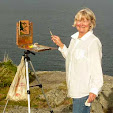Photo of Beaver Brook
In a previous post I introduced Carlson's Theory of Angles, a great approach to simplifying and understanding the values in landscape painting. Now I'd like to show another example, and a useful tool to help you see the values more easily. The photo above is Beaver Brook in Westford, MA, at a spot where I like to paint. Carlson's theory seems to be working, the sky is light, the marsh grass is a little darker and the trees are definitely the darkest. Is there a way to see this more clearly?
Yes, there is. You can turn the image to black and white, and then posterize it. Posterizing is the process of limiting the number of values in a photo. It's easiest to see in black and white, and we are looking for values, so that works well. You can do this with Photoshop and Photoshop Elements, but it can also be done with a free app on your phone, called Pixlr Editor (not Pixlr Collage, though I'm sure I can find a use for that one too!). It's available for iPhone and Android, and also for your computer. Below is a step by step demo.
Download the app to your phone.
Choose the photo that you'd like to process. you'll then be in the editing screen.
At the bottom of the editing screen, find Adjustment (second from left), and click that (see below).
Now you will see the screen below. Move the paintbrush slider to the left to change your image to black and white.
Click OK at the upper right, and you'll be back to the Edit screen. Now choose Effect (to the right of Adjustment) and find Posterize, near the far right, see below.
Click Posterize. You can use the slider to adjust the number of grays, the farther right you go, the fewer levels. Usually 4 works best, as we have here. Finally, click Save in the upper right. Now you have the posterized version, see below.
And Carlson's Theory is still looking pretty good.
Note: This can easily become a crutch, so use it to learn, but don't rely on it.







No comments:
Post a Comment